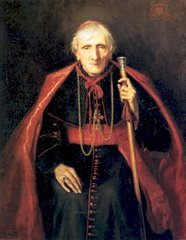A Synopsis of Michael R. Denton's Presentation to the Parousians on the Role of Suffering in Our Lives and in the Life of Christ as shown in Bishop Fulton J. Sheen's "Life of Christ."
Sheen believes that all of the world’s political and spiritual problems really come down to one fallacy: the divorce of Christ and His Cross. On one side, there are those who Sheen terms the “Christ-less Cross.” In Sheen’s day this was primarily the communists, but it also applies to many atheists. Those who view the world in this way see suffering. They see the hunger, the disease, the war, but that’s all they see. They see no redemption in it, no greater good or glory that can be achieved from suffering. On the other hand, there are those who favor the “Cross-less Christ.” These are the ones who view Jesus as merely a teacher similar to Confucius or Buddha, and believe that the Church ought to focus primarily on his teachings of love and forgiveness and forgo the “unnecessary” criticisms of the world’s morality. Even some of those who accept Jesus as Divine fall into this category, arguing that while the Crucifixion and Resurrection were necessary for our entrance into eternal life, they have no real impact on the way we should live our lives. Sheen argues that both of these views, which are united by their common disregard for the value of suffering in our lives, misinterpret Christ’s life. Every time Christ had the opportunity to choose between suffering and not suffering, Sheen argues, Christ chooses suffering. Christ however not only chooses this for Himself, through His teaching and His actions Sheen shows that He is also calling us to seek suffering, persecution, and humiliation as a necessary and the most important aspect of our discipleship.
Even before Christ was born, there were indications that He would be different from any other teacher in history. Jesus was the only person ever pre-announced. Sheen argues that this is significant, because if God really was going to send somebody who would come to us and unlock the secrets of truth, he would send out notification ahead of time. God did this not only through the many prophesies in the Judaic Scriptures that Jesus fulfilled throughout His life, he also gave inclinations of belief in the Gentiles. Sheen shows that the Romans, Greeks, and even some Eastern Asian cultures had at the time of Christ the sense that a Messiah was imminent. Jesus also differed from other teachers in His attitude to death. Most teachers, like Confucius or Buddha, were defeated in their teaching by death; that is they could no longer teach when they were dead so they sought to avoid death in order to prolong their teaching. Jesus on the other hand had His teaching fulfilled by His death. As Sheen says “every other person who ever came into this world came into it to live. He came into it to die.” Finally Sheen echoes an argument given by C.S. Lewis in Mere Christianity, namely that it is ridiculous to try to maintain the position that Jesus was simply a “good man.” Jesus proclaimed Himself to be divine and demanded that His Apostles die for Him. To make such requests if Jesus was simply a man and not Divine would make Jesus far less than a “good man;” rather they would make at best a lunatic and at worst a horrible fraud.
When Jesus was first born, He immediately set Himself up as a model for humiliation. Sheen points out that the very act of a Divine being becoming human is humiliating. Sheen asks us to imagine what it would be like to become a snail: to reduce ourselves to its size, it intelligence, not to mention the slime and other things that to us would be disgusting. How humiliating it would be for us to become a snail. How much more humiliating, Sheen says, must it be for a God to become man. So they very act of coming into this world as a man shows Jesus’ willingness to accept humiliation. When he finally arrived into the world, he found more humiliation. He was born into poverty, and was denied any room at an inn and was forced into a dirty manager. While Jesus remained in that manager, Sheen says that we see evidence of Jesus’ call for us to humble ourselves as well as the first reminder of the Cross. While in this manager, which was really a sort of cave, Sheen believes that the Wise Men when they came to visit Christ had to stoop low simply to enter the cave and approach Christ. Already we see the teaching: we must ourselves stoop down by humility in order that we may approach and come closer to Christ. The Wise Men, having stooped low, then give Jesus three gifts, one of which is myrrh. Myrrh, Sheen points out, is also used in the anointment of corpses. Already we see Calvary shadowing Christ.
When Jesus gets closer to His Ministry we see both the Miracle at Cana and the Temptations of Satan as ways in which Christ identifies His coming with suffering. When Mary at the wedding feast asks Jesus to help out the host for they have run short on wine. His response is “My Hour has not yet come.” When we usually hear this we think Jesus is here talking about His ministry. Sheen tells us however that all seven times the word for “hour” is used in the Gospel it is used in reference to His death. What Jesus then means when He tells Mary this is that if He does this miracle, His ministry has to begin and that that will mean His death. Here Jesus has made His ministry inextricable from His death; if He is to minister He is also to suffer and die. Mary is then given a choice: to keep Jesus and His glory all to herself or to allow Jesus to suffer and die as well as suffer herself so that Jesus might be shared amongst all of mankind. Mary chooses suffering by telling the servants “do whatever he tells you to” and becomes for us a model of suffering. Jesus then goes out into the desert and fasts for forty days, after which he is tempted by Satan. The first temptation of Satan is to turn the stones into bread. Satan is now tempting Jesus to eliminate suffering not only in Jesus’ stomach but also in the world. Here Satan is advancing the argument “Jesus, you have the power to eliminate suffering both in yourself and in all the world. Get rid of hunger, disease, and all other afflictions that cause suffering. In this you will be an economic savior to the world.” Instead, Jesus refuses and allows the pangs of hunger to continue to gnaw at Him. Then Satan invites Jesus to throw Himself down from the Temple and be caught by angels in a wild spectacle that will surely make men believe. Jesus however refuses. He does not want some wild stunt or even one of His miracles to be the standard of Christianity. Instead He wants the Cross, he wants His suffering and our willingness to suffer to be the standard by which we either believe or disbelieve. Finally, Satan tempts Christ to become a political savior like the Jews at the time largely believed the Messiah to be. Satan invites Jesus to have control over all the world if only He will worship Satan, that is Jesus can have his control and power as long as He tolerates evil. Jesus refuses, and He refuses knowing that to strike against evil will necessitate His own suffering.
The Beatitudes are usually the event pointed to most by those who would like something other than suffering to be the defining aspect of Jesus’ life. Sheen argues however that to interpret the Beatitudes as anything other than primarily to suffering is to miss the heart of the Beatitudes. Sheen has this to say about the Beatitudes:
“Let Him come into a world which tries to interpret man in terms of sex; which regards purity as coldness, chastity as frustrated sex, self-containment as abnormality, and the union of husband and wife until death as boredom; which says that a marriage endures only so long as the glands endure, that one may unbind what God binds and unseals what God seals. Say to them “Blessed are the pure;” and He will find Himself hanging naked on a Cross, made spectacle to men and angels in a last wild crazy affirmation that purity is abnormal, that the virgins are neurotics, and that carnality is right.”… “The Beatitudes cannot be taken alone: they are not ideals; they are hard facts and realities inseparable from the Cross of Calvary. What he taught was self-crucifixion: to love those who hate us; to pluck out eyes and cut off arms to prevent sinning; to be clean on the inside when the passions clamor for satisfaction on the outside; to forgive those who would put us to death; to overcome evil with good; to bless those who would curse us; to stop mouthing freedom until we have justice, truth, and love of God in our hearts as the condition of freedom; to live in the world and still keep oneself unpolluted from it; to deny ourselves sometimes legitimate pleasures in order to better crucify our egotism-all this is to sentence the old man in us to death.”
There are two things we can take from this. The first is that just living the Beatitudes is a call to persecution. Whether one preaches to the world about the need for chastity or simply lives it in his or her own life that disciple is standing against what the world holds dear, and the world does not like any opposition for that reminds the world of its sin. So to choose to live the life prescribed by the Beatitudes is to choose to live a life of suffering. Second, when Jesus is calling us to help the poor and love our enemies He is calling us to endure suffering. It is a sacrifice to give our time to the poor and it might be humiliating to have to wear a mask while ripping out the rotten walls of flooded homes in New Orleans. So in the Beatitudes Jesus is calling us to a life of service, and that service is summarized as choosing suffering, persecution, and humiliation for His glory.
The idea of the suffering Messiah is foreign to the world now, but it was also foreign to Peter. At the Transfiguration, Peter sees Jesus clothed in brilliant white surrounded by the great figures of the Old Testament and in this he sees the great glory of Christ. He is so impressed by this that he wants to set up camp, or really to shelter the group away from the world so that Peter can only bask in the glory. Jesus instead refuses this. Elijah and Moses disappear, Jesus’ vestments return to being dirty, and Jesus becomes once again the weary traveler. Jesus had the opportunity to choose glory or suffering, since by setting out again Jesus was setting out towards the Cross. Jesus at every opportunity chose suffering over glory. Eventually this would be manifested in the Cross itself, and I need not go into detail of the extreme suffering and humiliation he suffered there. However, once He is one the Cross He does two things to show us that this was the greatest thing He had done and as such was what we as disciples need to most emulate. He said “It is accomplished.” He did not say that after the wonderful teachings of the Sermon on the Mount, when the crowds around him swelled on a grassy hill and were in awe of His wisdom. He said it while he was bloody, naked, and dying on a wooden cross with the people taunting and mocking Him below. Jesus only fulfilled His mission when He had fully shown people to accept persecution, suffering, and humiliation when He Himself had accepted. Then He does the second thing to show the importance of suffering and humiliation: He dies. Sheen points out that as an omnipotent being, Jesus would have to will Himself to die in order to die. Jesus here is choosing once more to undergo the worst humiliation and suffering: death. By doing so we too are called to be willing to die for Him.
If anything, Sheen’s “Life of Christ” points out to us that in everything Jesus said, taught, or did there is a call to be willing to be persecuted, to be humiliated, and to suffer so that His work may be furthered. We can take comfort in knowing that He suffered too and that He will be with us every moment. I’d like to close with this from John 15:18-19
“If the world hates you, it hated me first, as you know well. If you belonged to the world, the world would love you as its own; but because you do not belong to the world, because I have chosen you out of the world, for that reason the world hates you.”
Monday, October 30, 2006
Subscribe to:
Post Comments (Atom)






No comments:
Post a Comment